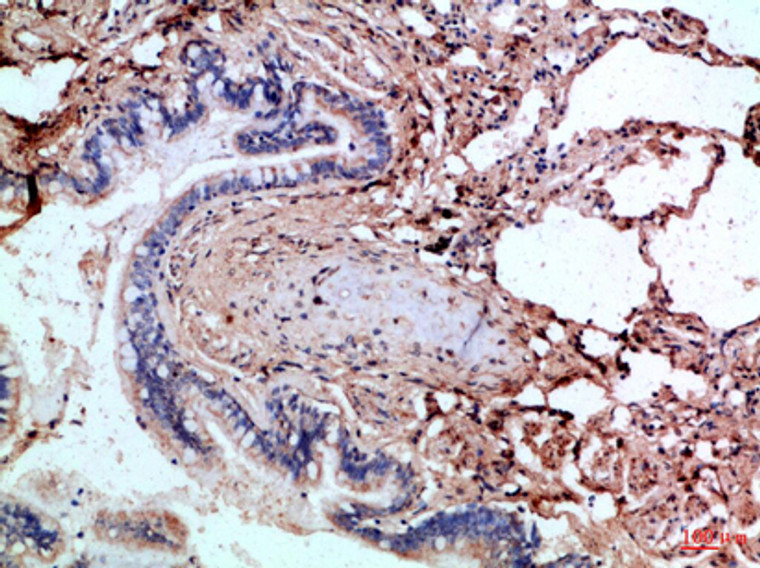-
Immunohistochemical analysis of paraffin-embedded Human-lung, antibody was diluted at 1:100
-
Western blot analysis of lysates from 1) 293T, 2) Hela, 3) MCF-7, 4) Hela-UV cells, (Green) primary antibody was diluted at 1:1000, 4°C over night, secondary antibody (cat: (NA) was diluted at 1:10000, 37°C 1hour. (Red) Tubulin Beta monoclonal antibody (5G3) (cat: (STJ96932) antibody was diluted at 1:5000 as loading control, 4°C over night, secondary antibody (cat: (NA) was diluted at 1:10000, 37°C 1hour.
-
Immunohistochemical analysis of paraffin-embedded Human-skin, antibody was diluted at 1:100
-
Immunohistochemical analysis of paraffin-embedded Human-lung, antibody was diluted at 1:100
-
Western blot analysis of 293T Hela MCF-7 Hela-UV MCF-7-UV KB-UV cells using Caspase-1 Polyclonal Antibody diluted at 1:1000. Secondary antibody was diluted at 1:20000
-
Immunohistochemical analysis of paraffin-embedded Human-skin, antibody was diluted at 1:100
-
Immunohistochemical analysis of paraffin-embedded Rat-spleen tissue. 1, Caspase-1 Polyclonal Antibody was diluted at 1:200 (4°C, overnight). 2, Sodium citrate pH 6.0 was used for antibody retrieval (>98°C, 20min). 3, Secondary antibody was diluted at 1:200 (room tempeRature, 30min). Negative control was used by secondary antibody only.
-
Immunohistochemical analysis of paraffin-embedded Mouse-liver tissue. 1, Caspase-1 Polyclonal Antibody was diluted at 1:200 (4°C, overnight). 2, Sodium citrate pH 6.0 was used for antibody retrieval (>98°C, 20min). 3, Secondary antibody was diluted at 1:200 (room tempeRature, 30min). Negative control was used by secondary antibody only.
-
Immunohistochemical analysis of paraffin-embedded Rat-lung tissue. 1, Caspase-1 Polyclonal Antibody was diluted at 1:200 (4°C, overnight). 2, Sodium citrate pH 6.0 was used for antibody retrieval (>98°C, 20min). 3, Secondary antibody was diluted at 1:200 (room tempeRature, 30min). Negative control was used by secondary antibody only.
-
Immunohistochemical analysis of paraffin-embedded Human-uterus tissue. 1, Caspase-1 Polyclonal Antibody was diluted at 1:200 (4°C, overnight). 2, Sodium citrate pH 6.0 was used for antibody retrieval (>98°C, 20min). 3, Secondary antibody was diluted at 1:200 (room tempeRature, 30min). Negative control was used by secondary antibody only.
-
Immunofluorescence analysis of rat-lung tissue. 1, Caspase-1 Polyclonal Antibody (red) was diluted at 1:200 (4°C, overnight). 2, Cy3 labled Secondary antibody was diluted at 1:300 (room temperature, 50min).3, Picture B: DAPI (blue) 10min. Picture A:Target. Picture B: DAPI. Picture C: merge of A+B
-
Immunofluorescence analysis of rat-lung tissue. 1, Caspase-1 Polyclonal Antibody (red) was diluted at 1:200 (4°C, overnight). 2, Cy3 labled Secondary antibody was diluted at 1:300 (room temperature, 50min).3, Picture B: DAPI (blue) 10min. Picture A:Target. Picture B: DAPI. Picture C: merge of A+B
-
Western blot analysis of lysates from 1) 293T, 2) Hela, 3) MCF-7, 4) Hela-UV cells, (Green) primary antibody was diluted at 1:1000, 4°C over night, secondary antibody (cat: (NA) was diluted at 1:10000, 37°C 1hour. (Red) Tubulin Beta monoclonal antibody (5G3) (cat: (STJ96932) antibody was diluted at 1:5000 as loading control, 4°C over night, secondary antibody (cat: (NA) was diluted at 1:10000, 37°C 1hour.

















